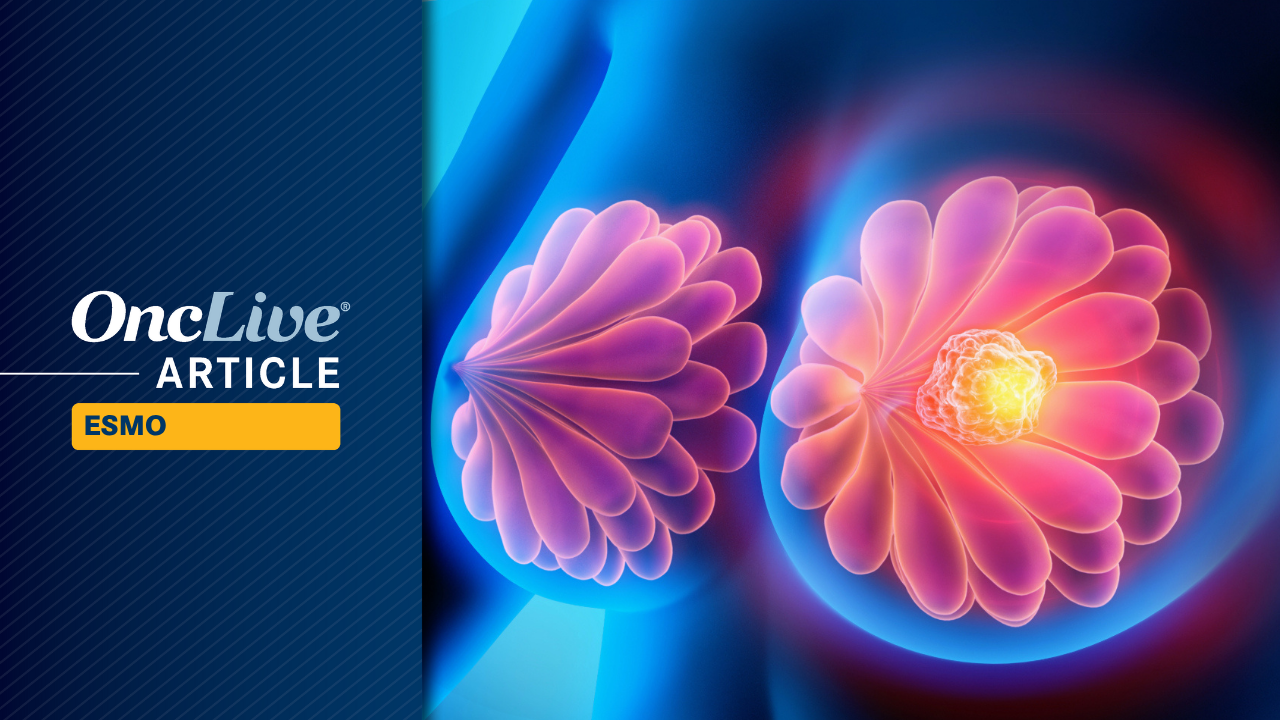Human sperm can swim through surprisingly viscous fluids with ease – and they seemingly defy Newton’s third law of motion to do so.
To figure out how they slither through substances that should, in theory, resist their movement, a team led…

Human sperm can swim through surprisingly viscous fluids with ease – and they seemingly defy Newton’s third law of motion to do so.
To figure out how they slither through substances that should, in theory, resist their movement, a team led…

Neoadjuvant treatment with fam-trastuzumab deruxtecan-nxki (T-DXd; Enhertu) followed by paclitaxel, trastuzumab (Herceptin), and pertuzumab (Perjeta; THP) led to an improvement in pathologic complete response (pCR) rate compared with dose-dense doxorubicin and cyclophosphamide plus THP (ddAC-THP) in patients with high-risk, HER2-positive early breast cancer, according to data from the phase 3 DESTINY-Breast11 trial (NCT05113251).1
Findings presented at the
“DESTINY-Breast11 showed the highest reported pCR rate in HER2-positive early breast cancer for a registrational study in the neoadjuvant setting, despite—if you want to do cross-trial comparisons—a high prevalence of hormone receptor–positive disease and a high-risk population,” lead study author Nadia Harbeck, MD, PhD, said in a presentation of the data.
Harbeck is director of the Breast Center and chair for Conservative Oncology at the Department of OB&GYN at LMU University Hospital in Munich, Germany.
Harbeck noted that current neoadjuvant standard-of-care (SOC) regimens for HER2-positive early breast cancer have remained unchanged for more than a decade. As such, investigators sought to evaluate T-DXd–based treatment in this population with the goal of improving efficacy and safety vs the current SOC.
The randomized, global, multicenter, open-label study enrolled patients with previously untreated HER2-positive early breast cancer who had high-risk disease, defined as ≥cT3 and N0-3 or cT0-4 and N1-3; or inflammatory breast cancer. Patients were allowed to enroll, irrespective of hormone receptor status.
Patients were randomly assigned in a 1:1:1 fashion to receive T-DXd followed by THP; ddAC-THP; or T-DXd alone, followed by surgery in all arms. In the first arm, patients received 4 cycles of T-DXd followed by 4 cycles of THP. In the second, ddAC was administered for 4 cycles, followed by 4 cycles of THP. In the final arm, patients received T-DXd alone for 8 cycles.
Notably, the T-DXd monotherapy arm was closed in March 2024, following a recommendation from the study’s independent data monitoring committee.
After surgery, study protocols called for the following treatments, irrespective of arm:
The study’s primary end point was pCR rate (ypT0/Tis ypN0) per blinded independent central review (BICR) assessment. Secondary end points included BICR-assessed pCR rate (ypT0 ypN0), event-free survival (EFS), safety, pharmacokinetics, invasive disease-free survival, overall survival, and health-related quality of life. Residual cancer burden (RCB) was an additional outcome measured during the study.
At data cutoff, 16.9% of patients in the T-DXd plus THP arm discontinued a study drug, including T-DXd (2.8%), paclitaxel (14.4%), trastuzumab (2.2%), and pertuzumab (2.2%); 97.2% of patients in this arm proceeded to surgery. In the ddAC-THP arm, 13.8% of patients had discontinued any study treatment, including AC (2.9%), paclitaxel (12.0%), trastuzumab (3.0%), and pertuzumab (3.7%); 93.8% of patients in this arm underwent surgery. In the T-DXd monotherapy arm (n = 286), 18.4% of patients discontinued study treatment, and 95.8% underwent surgery.
Regarding post-neoadjuvant treatments, 99.1% of evaluable patients in the T-DXd arm who achieved a pCR (n = 226) underwent any adjuvant therapy, comprising any cytotoxic chemotherapy regimen (5.8%), any T-DM1–containing regimen (1.8%), and any trastuzumab-containing regimen (94.2%). In the ddAC-THP, 98.4% of patients who achieved a pCR (n = 190) underwent any adjuvant therapy, including any cytotoxic chemotherapy regimen (5.8%), any T-DM1–containing regimen (2.1%), and any trastuzumab-containing regimen (91.6%).
For patients who did not achieve a pCR, any adjuvant therapy was administered to 89.5% of patients in the T-DXd plus THP arm (n = 95) and 82.3% of patients in the ddAC-THP arm (n = 130). In the experimental group, adjuvant therapies included any cytotoxic chemotherapy regimen (10.5%), any T-DM1–containing regimen (52.6%), and any trastuzumab-containing regimen (38.9%). These respective rates were 9.2%, 56.9%, and 26.2% in the control group.
In the T-DXd plus THP and ddAC-THP arms, the median age was 50 years (range, 25-82) and 50 years (range, 23-79), respectively. All patients in both arms were female. The highest proportion of patients in each arm was from Asia (T-DXd plus THP, 47.4%; ddAC-THP, 47.5%) and were Asian (49.8%; 49.1%). Most patients had an ECOG performance status of 0 (86.6%; 87.5%), had immunohistochemistry 3+ HER2-positive disease (87.2%; 88.4%), had cT0-2 tumors (54.8%; 58.8%), and had positive lymph nodes (89.4%; 87.8%).
Findings also showed that 81.3% of patients in the T-DXd plus THP arm had no RCB (RCB-0) or minimal RCB (RCB-1) in resected breast or lymph node tissue compared with 69.1% in the ddAC-THP arm (difference, 12.2%). In the hormone receptor–positive population, the RCB-0 plus RCB-1 rates were 78.0% for T-DXd plus THP vs 64.7% for ddAC-THP; these respective rates were 90.4% and 81.2% in the hormone receptor–negative population.
Investigators also reported an EFS trend favoring T-DXd plus THP, with data at 4.5% maturity (HR, 0.56; 95% CI, 0.26-1.17). Maturity for the data cutoff of the trial’s final analysis is predicted at approximately 10%. The 24-month EFS rates were 96.9% (95% CI, 93.5%-98.6%) in the T-DXd plus THP arm vs 93.1% (95% CI, 88.7%-95.8%) in the ddAC-THP arm.
Any-grade adverse effects (AEs) occurred in 98.1% of patients in the T-DXd plus THP arm compared with 98.7% of patients in the ddAC-THP arm. The respective rates of grade 3 or higher AEs were 37.5% and 55.8%. Any-grade serious AEs were reported in 10.6% and 20.2% of patients, respectively.
In the T-DXd plus THP arm, AEs led to dose any dose reduction, any drug interruption, and any treatment discontinuation in 18.1%, 37.8%, and 14.1% of patients, respectively. In the ddAC-THP group, these rates were 19.2%, 54.5%, and 9.9%, respectively. AEs led to death in 0.6% of patients in both arms. AEs led to delays in surgery in 3.4% of patients in the experimental arm vs 2.6% of patients in the control arm.
Regarding AEs of special interest, any-grade drug-related adjudicated interstitial lung disease (ILD) was 4.4% in the T-DXd plus THP arm vs 5.1% in the ddAC-THP arm. The rates of grade 3 or higher ILD were 0.6% and 1.9%, respectively. Grade 5 ILD occurred in 1 patient (0.3%) in both groups. Any-grade left ventricular dysfunction occurred in 1.3% of patients in the experimental arm vs 6.1% of patients in the control arm. The rates of grade 3 or higher left ventricular dysfunction were 0.3% and 1.9%, respectively, although no grade 5 events were reported in either group.
Any-grade treatment-emergent AEs reported in at least 20% of patients in either arm included nausea (T-DXd plus THP, 64.7%; ddAC-THP, 51.6%), diarrhea (58.8%; 54.2%), alopecia (47.5%; 49.0%), fatigue (41.3%; 54.8%), increased transaminase levels (34.4%; 33.7%), neutropenia (29.1%; 44.2%), constipation (29.1%; 24.4%), vomiting (28.8%; 21.2%), peripheral neuropathy (25.9%; 20.8%), anemia (22.8%; 49.7%), stomatitis (18.4%; 27.9%), and leukopenia (17.2%; 23.4%).
When the T-DXd monotherapy arm, patients were allowed to remain on therapy or immediately switch to local SOC. If patients switched therapy, they were classified as having a non-pCR.
Findings from the monotherapy arm showed that patients (n = 286) achieved a pCR rate of 43.0% at the primary analysis and 51.4% at a prespecified supplementary analysis. EFS data were similar between T-DXd monotherapy and ddAC-THP (HR, 0.82; 95% CI, 0.41-1.62), and the 24-month EFS rate in the T-DXd monotherapy group was 94.4% (95% CI, 90.5%-98.7%).
Regarding safety, 97.5% of patients treated with T-DXd alone (n = 283) experienced any-grade AEs, 22.6% had grade 3 or higher AEs, and 10.2% had any-grade serious AEs. AEs led to dose reduction, drug interruption, and treatment discontinuation in 6.7%, 18.0%, and 7.8% of patients, respectively. One patient (0.4%) experienced an AE that led to death. AEs led to surgical delay in 6.4% of patients.
The rate of any-grade, drug-related adjudicated ILD was 4.9% in the T-DXd monotherapy arm, although all instances were grade 1 or 2. Left ventricular dysfunction occurred in 0.7% of patients, all at grade 1 or 2.
Based on data from DESTINY-Breast11, the FDA accepted a supplemental biologics license application seeking the approval of neoadjuvant T-DXd followed THP for the treatment of adult patients with high-risk, HER2-positive (IHC 3+ or in situ hybridization–positive), stage II/III breast cancer.2
The FDA has assigned a target action date of May 18, 2026, under the Prescription Drug User Fee Act.
“DESTINY-Breast11 results support T-DXd [plus] THP as a more effective and less toxic neoadjuvant treatment compared with ddAC-THP, and it may become the preferred regimen for patients with high-risk, HER2-positive early breast cancer,” Harbeck concluded in her presentation.1
Disclosures: Harbeck reported receiving honoraria from AstraZeneca, Daiichi Sankyo, Gilead, Lilly, Menarini Stemline, MSD, Novartis, Pfizer, Pierre Fabre, Roche, Viatris, and Zuellig Pharma; serving as a consultant or advisor for Exact Sciences, Gilead, Pfizer, Roche, and Sandoz; having an institutional site contract with AstraZeneca; serving as a data safety monitoring board or advisory board member for Gilead, IQVIA, and Roche; and having ownership interested in the West German Study Group.

I love the 30 Days of Night franchise, so I was super excited to discover this week that it’s picking back up with Falling Sun, and this first issue did not disappoint. 30 Days of Night: Falling Sun is written by Rodney Barnes (Killadelphia), who…

Djorden Santos and Danny Barlow engaged in a wildly entertaining back-and-forth battle in the middle of Saturday’s preliminary card at Rogers Arena in…

Maxwell Djantou Nana is a knockout machine, having scored KOs in every single one of his victories up until his PFL Africa First Round matchup. In fact, Nana has won seven straight since dropping his July 2022 MMA debut….

Dylan Sprouse demonstrated unwavering support for his wife, Barbara Palvin, at the 2025 Victoria’s Secret Fashion Show held on October 15, 2025, at Steiner Studios in Brooklyn, New York City. Despite a fractured foot and recent…

Domantas Sabonis suffered a hamstring injury October 15 and will miss the start of the season.
SACRAMENTO, Calif. (AP) — Sacramento Kings big man Domantas Sabonis will miss the start of the season with a hamstring injury.
The Kings said…

Decades of clinical research has led to the discovery of key biomarkers, development of novel agents, and the subsequent improvement in patient survival outcomes.
At the European Society for Medical Oncology 2025 Congress, Jürgen Wolf, MD, medical director at the Center for Integrated Oncology, and chair of the Lung Cancer Program at Center for Integrated Oncology at the University Hospital of Cologne, shared key updates in non-small cell lung cancer (NSCLC) treatment. He discussed novel drugs and emphasized the crucial role of molecular diagnostics in guiding treatment decisions to ensure every patient receives the right therapy at the right time.
Lung cancer represents the second most common cancer in the United States, with over 260,000 new cases in 2025. NSCLC is the most prevalent type of lung cancer, representing roughly 80% to 85% of cases. Pivotal advancements in drug development have significantly improved survival rates for patients over the past 40 years—12.4% in the mid-1970s to 26.7% by 2020. Various investigational and FDA approved agents are responsible—from tyrosine kinase inhibitors (TKIs) to other targeted therapies.1-3
However, mutations present continued obstacles to optimal outcomes. In NSCLC, there are various mutations not limited to EGFR, ALK fusion, ROS1, BRAF V600E, HER2, and KRAS. Wolf discussed the benefit of molecular diagnostic testing even prior to initiation of therapy for NSCLC. Liquid biopsy has a high specificity but limited sensitivity. He establishes tissue biopsy as the continuing gold standard for molecular diagnostics.4
“Molecular diagnostics remains the foundation of personalized care in [NSCLC],” Wolf said. “Comprehensive testing before first line therapy should include all guideline recommended markers. RNA next-generation sequencing is essential for sensitive fusion detection.”4
EGFR mutations are the most common in NSCLC—representing 10% to 15% of lung adenocarcinomas. It is more prevalent and in nonsmokers, women, and Asian populations, with exon 19 deletion and exon 21 L858R being the most frequent mutations. In the adjuvant setting following surgery, osimertinib (Tagrisso; AstraZeneca), a TKI, is the standard of care with proven overall survival (OS) benefit in resected early-stage NSCLC.4,5
Osimertinib’s successfully secured multiple FDA approvals, supported by data showing its efficacy in adjuvant and neoadjuvant settings. The first approval was supported by data from the randomized, double-blind, placebo-controlled ADAURA trial (NCT02511106). Four years later, the FDA granted osimertinib another approval in the adjuvant setting supported by data from the double blind, randomized, placebo-controlled LAURA trial (NCT03521154).6-9
Wolf highlights the FLAURA-2 and MARIPOSA trials (NCT04035486; NCT04487080), which is exploring osimertinib as a monotherapy. Both trials had a primary end point of progression-free survival (PFS) and OS and showed osimertinib’s superiority over other available TKIs. OS was favorable and similar between both trials at 60% vs 51% (for combination vs monotherapy) in MARIPOSA and 63% vs 51% (for combination vs monotherapy) in FLAURA-2. The researchers report an approximate 10 to 12 months improvement with a hazard ratio of 0.75 for both trials.4,10,11
Compared with combination therapies, osimertinib as a monotherapy was associated with less toxicity. Combination therapies yielded more severe adverse events (AEs) and higher rates of treatment interruption. Patients in FLAURA-2 experienced chemotherapy-associated side effects, while MARIPOSA patients had painful infusion reactions such as rash and pulmonary embolism.4
“However, this improved efficacy comes at the cost… combination therapies are significantly more toxic than monotherapy,” explained Wolf. “But I think it’s fair enough to say that toxicity management has improved substantially with prophylactic skincare, subcutaneous formulation and anti-coagulation. Nevertheless, they remain challenging in clinical routine.”4
However, osimertinib shows additional efficacy across as a neoadjuvant treatment. Wolf highlights the NEOADURA trial (NCT04351555), a randomized phase 2 trial comparing osimertinib to placebo. The primary end point was major pathological response, which showed a clear advantage for osimertinib.4,12
“I think this is really an attractive option for these patients, and should be considered and discussed in the tumor growth.”4
ALK fusions are detected in approximately 1% to 4% of lung cancers, most often in adenocarcinomas. These alterations tend to occur in younger patients and those with minimal smoking history. Alectinib (Alecensa; Genentech) is the current standard-of-care therapy for ALK-positive NSCLC and received FDA approval in 2024 for adjuvant use following tumor resection.2,4
Wolf highlights other approved agents in this setting including lorlatinib (Lorbrena; Pfizer Inc) and crizotinib (Xalkori; Pfizer), which were compared head-to-head in the CROWN trial (NCT03052608).4,13
“Lorlatinib has been tested in a phase 3 study against crizotinib, which has already shown progression-free survival benefits in use,” said Wolf, “and it’s a better drug—65% versus around 40% with the second-generation inhibitors.”4
CROWN results showed a 5-year PFS of 60% in lorlatinib with favorable brain activity. In patients without initial brain metastases, the data showed a hazard ratio of 0.05 for central nervous system progression.Permanent discontinuation rates were 11% vs 7%.4
“However, there are still a lot of reservations against this drug, and this is based on new side effects, such as hydrochlorist weight gain and, in particular, neurologic AEs,” Wolf explained. “There were also some reservations from patients about stem cell use, but when we look at the permanent discontinuation rates from the trial—11% versus 7%—it’s not necessarily more toxic. There’s a learning curve involved.”4
ROS1 rearrangements account for 1% to 2% of NSCLC cases with an estimated 10,000 to 15,000 new cases every year around the world. Although relatively uncommon in comparison to other mutations. Patients with ROS1 mutations are younger with a history of light smoking; however, some diagnosed patients have no history of smoking.14
ROS1 mutated lung cancers exhibit clinical similarities to ALK-rearranged NSCLC, though ROS1, EGFR, and ALK rearrangements are generally mutually exclusive. After exposure to TKIs, a subset of ROS1-positive tumors acquires secondary driver mutations, predominantly in KRAS or EGFR.4
“For ROS1 fusions, we have active TKIs approved in the first line—entrectinib (Rozlytrek; Genentech), crizotinib, and epotrectinib (Augtyro; Bristol Myers Squibb)—entering for resistant fusions,” said Wolf. “In this field, we already have a next-generation agent approved now after TKI failure.”4
HER2 mutations are seen across cancer types. In lung cancer, they are rarer than ROS1 and ALK fusions, occurring in approximately 0.2% of patients. Wolf highlights datopotamab deruxtecan-dlnk (Datroway;_Daiichi Sankyo, Inc) and zongertinib (Hernexeos; Boehringer Ingelheim Pharmaceuticals, Inc), which are both FDA approved for treatment of patients with NSCLC as of 2025. D-DXd is approved for adults with locally advanced or metastatic EGFR-mutated NSCLC who received prior EGFR-directed therapy and platinum-based chemotherapy.4,15
Zongertinib is the most recent approval for adults with unresectable or metastatic nonsquamous NSCLC whose tumors have HER2 mutations based on positive data from the Beamion LUNG-1 trial (NCT04886804).16,17
Beamion LUNG-1 is an open-label, phase 1 dose escalation trial evaluating zongertinib as a monotherapy in patients with unresectable or metastatic, nonsquamous NSCLC with HER2 TKD mutations. The overall response rate was about 75% (95% CI, 63–83), with 58% experiencing a duration of response of 6 months or longer.18
KRAS G12C mutations represent one of the most significant oncogenic drivers in lung cancer, though therapeutic progress in this space has historically been limited. Currently, only two targeted therapies—sotorasib (Lumakras; Amgen) and adagrasib (Krazati; Mirati Therapeutics)—have received FDA approval, both indicated for second-line treatment following chemotherapy.4
Despite these advances, clinical benefit remains modest, with disease-free survival rates around 30% and a median duration of response of approximately 5 to 6 months. Although both agents have demonstrated improvements compared with docetaxel, outcomes underscore the ongoing need for more durable and effective options.4
The field of KRAS inhibition is rapidly evolving, with multiple next-generation agents currently in clinical development. Ongoing studies are exploring monotherapy and combination approaches, as well as agents that target the GDP-bound (inactive) form of KRAS and emerging pan-KRAS inhibitors designed to address resistance and broader mutation coverage.4
Conclusion
The evolution of molecularly targeted therapies has transformed the treatment landscape of NSCLC, turning what was once a fatal disease into one defined by precision and personalization. As highlighted by Wolf, the continued integration of comprehensive molecular diagnostics remains essential to ensuring that each patient receives the most effective therapy for their unique tumor profile. According to Wolf:
“Continuous innovation demands not only better products, but also better data, smarter networks and genuine partnership with our patients to guide everyday decisions”

Klaus Doldinger, the German saxophonist and composer who created the soundtracks to Wolfgang Petersen’s Das Boot and The NeverEnding Story, had died. He was 89.
Doldinger died on Oct. 16, his family confirmed to German press agency…